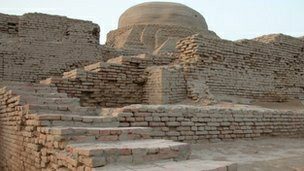Monika tells us about the famous Dancing Girl figurine of Mohenj0-Daro, tracing its historical and aesthetical pieces of evidence. An exclusive for Different Truths.
 “Mound of the Dead”, which we commonly call Mohenjo-Daro, dates to prehistorical Indus Valley Civilisation. The city of Mohenjo-Daro is believed to evolve between 2600 and 1900 BCE. But it was only in the early 20th century, the site was discovered. Now, the site is in Sindh, Pakistan.
“Mound of the Dead”, which we commonly call Mohenjo-Daro, dates to prehistorical Indus Valley Civilisation. The city of Mohenjo-Daro is believed to evolve between 2600 and 1900 BCE. But it was only in the early 20th century, the site was discovered. Now, the site is in Sindh, Pakistan.
About 6,000 years back, this civilisation was found under the earth, with entire human and animal race buried underneath and that’s the reason, it was given the name ‘Mound of the Dead’.
The arts of Indus Valley Civilisation (IVC), one of the initial civilisations of the world, emerged during the Bronze Age.
The successive excavations not only revealed the archaeological importance of the site but also unfolded the rich cultural significance of the civilisation. The arts of Indus Valley Civilisation (IVC), one of the initial civilisations of the world, emerged during the Bronze Age. The types of art and artefacts found from various sites of civilisation include sculptures of bronze and soapstone, terracotta figurines; gold, silver, stones and shell ornaments; seals and pottery.
IVC is famous for many reasons but what took the whole world into its stride was probably the discovery of an enigmatic slender-limbed statuette, known as the “Dancing Girl of Mohenjo Daro” or “Indus Dancing Girl”. This 2500 BCE figurine is a masterpiece in making. The extraordinary quality of it is compared with the antiquity Late Classical and Hellenistic Greek sculptures.
This momentous 4500-year-old bronze statue was found, in 1926, from the ruins of a small house on the 9th Lane of Hargreaves Area, commonly called ‘HR Area’ by the famous Bristol archeologist Ernest J. H. Mackay.
This momentous 4500-year-old bronze statue was found, in 1926, from the ruins of a small house on the 9th Lane of Hargreaves Area, commonly called ‘HR Area’ by the famous Bristol archeologist Ernest J. H. Mackay. Interestingly, the figure was given the name ‘Dancing Girl’ by her upright dancing position and inference of being a dancer.
The figure is approximately 10.5cms in height and exhibits a unique gesture of left leg and a backward tilt of the right one; right arm with a little bend placed on her hip and left hand placed on the knee; which presumably depicts a dancing position but no sources to prove it.
According to archeologist Gregory Possehl, Dancing Girl is one of the most gorgeous pieces of the art, which were found from IVC site.
According to archeologist Gregory Possehl, Dancing Girl is one of the most gorgeous pieces of the art, which were found from IVC site. Though not confirming the position and profession of the figurine, he insists on her confident and poised portrayal.
The figure also exhibits the presence of a rich cultural legacy. One upper arm of the girl is wholly filled, with almost twenty-five bangles giving her an appearance of a tribal or a Banjara lady. Her necklace has three big pendants. Her long hair fanned in a big bun that rests on her shoulder. This type of hairstyle and ornamental fashion sense was supposed to be more famous in the modern population of Nubia women. Nevertheless, this reveals that performing arts too had found a way to be an integral part of the civilization, probably as a method of entertainment.
It is noteworthy that Harappan civilisation, which disappeared during circa 2500- 2000 B.C was rich in copper and bronze objects.
Indus civilisation was famous for the metal bending. In the making of this bronze figurine, the artistry technique of ‘lost-wax casting’ was used. It is noteworthy that Harappan civilisation, which disappeared during circa 2500- 2000 B.C was rich in copper and bronze objects. They were versed with not only copper metallurgy but also the bronze technology giving a clear picture that people were well equipped and versed with the tedious smelting process. This proves that it was no doubt a revolutionary event in the history of mankind. It was metal that enhanced socio-economic development in that civilisation.
Though there are many versions and manifestations about the originality of the “Indus Dancing Girl” but one thing is beyond an ounce of doubt that this miniature model reveals a plethora of unmentioned proficiencies of Harappan and Indus Valley civilisation.
Though there are many versions and manifestations about the originality of the “Indus Dancing Girl” but one thing is beyond an ounce of doubt that this miniature model reveals a plethora of unmentioned proficiencies of Harappan and Indus Valley civilisation. This bronze figurine is hardly four inches in length, but it describes the faculty of craftsmanship and the aesthetic sense during that period of time. It wouldn’t be an exaggeration to say that this little dancing girl changed the ethos of art in India and abroad.

References:
-
Mohenjo-Daro and Harappa Civilisation › artifacts.
-
Wikipedia, Indus Valley Civilisation
-
Wikipedia, Harappan civilisation
-
National Geographic
-
Wikipedia, Ancient Greek Art
Bibliography:
- Bronze Age: The Bronze Age is a historical period characterised by the use of bronze and in some areas proto-writing (communicating with symbols and marks) and other early features of urban civilisation
- Soapstone
- Lost-wax casting: A process by which a duplicate metal sculpture is cast from an original sculpture to get intricate designs.
- Nubia: A region along the Nile river; it was the seat of one of the earliest civilisation of ancient Africa dating back to 2500 BC onward.
- HR Area: Large courtyard from Harappan site of almost 70 rooms from where fourteen skeletons of so-called massacre victims were discovered.
- Late Classical Greek Art: Dating back to 400–300 BC, an increased emphasis on the expression of emotion in art/sculptures.
- Hellenistic Greek Art: The art of the Hellenistic period generally taken to begin with the death of Alexander the Great in 323 BC and end with the conquest of the Greek world by Romans. Very sophisticated luxury artwork thrived in this period.
Photos sourced by the author from the Internet






 By
By
 By
By

 By
By
Beautiful history and our past-thnak you!
Hi Monika:
Thanks for the beautiful article. Is the picture of the dancing girl copyrighted? I am writing a story about the dancing girl and would like to include the picture. Who do I get the permission from? Thanks.
Arshud
Thank you Arshud for your kind words. I’m glad you liked my article. Humbled beyond words.
The right to publish a copyrighted image is controlled by the copyright owner, so each copyrighted image that you use must have permission or fall within an exception to the general copyright statue, such as public domain, fair use, or open access.
A pic is worth a thousand words. You must cite or credit the source. That’s a logical thing to do.
Hope it helps.
Love n Light.